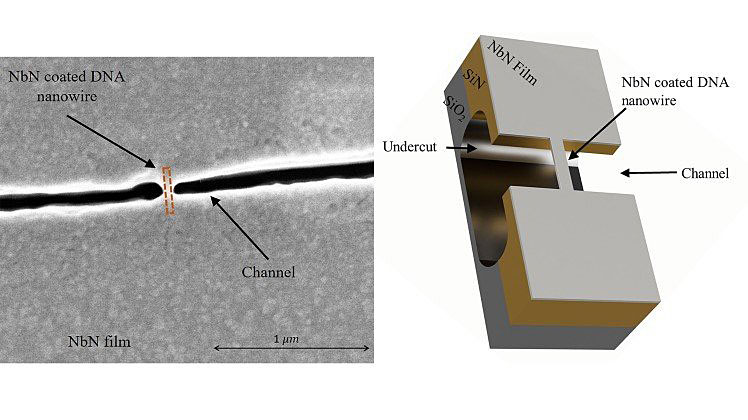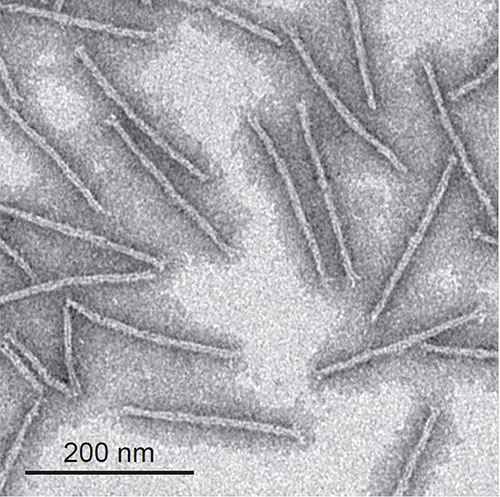DNA Origami Enables Fabricating Superconducting Nanowires
Fabricating nanoelectronic circuits of the future just got a lot more interesting, thanks to DNA origami
January 19, 2021
 enlarge
enlarge
(left) Schematic illustration of a niobium nitrate-coated DNA nanowire suspended above a silicon nitride/silicon oxide channel. (right) High-resolution scanning electron microscope (HR-SEM) image of the channel (black in image) on which the DNA nanowire is suspended. In the image, the channel appears discontinuous, reflecting the DNA suspended across it (marked by dashed orange rectangle). The distance between the two sides of the channel is ~50 nanometers, and the width of the niobium nitrate-coated nanowire at its narrowest point is ~25 nanometers. Credit: Lior Shani, Philip Tinnefeld, Yafit Fleger, Amos Sharoni, Boris Shapiro, Avner Shaulov, Oleg Gang, and Yosef Yeshurun
The following news release, issued by the American Institute of Physics (AIP) on Jan. 19, describes research published in AIP Advances on exploiting DNA origami as a platform to build wire-like nanostructures that can conduct electricity without resistance. Scientists from the U.S. Department of Energy’s (DOE) Brookhaven National Laboratory and collaborating institutions first reported this platform in Nature Communications last November. Oleg Gang, leader of the Soft and Bio Nanomaterials Group at Brookhaven Lab’s Center for Functional Nanomaterials—a DOE Office of Science User Facility—has been developing novel strategies using DNA to guide the self-assembly of nanoparticles in desired ways for particular applications. The new AIP study shows the potential of this platform for applications including interconnects for nanoelectronics and novel devices such as 3-D magnetometers for measuring magnetic fields.
WASHINGTON, January 19, 2021 — The quest for ever-smaller electronic components led an international group of researchers to explore using molecular building blocks to create them. DNA is able to self-assemble into arbitrary structures, but the challenge with using these structures for nanoelectronic circuits is the DNA strands must be converted into highly conductive wires.
Inspired by previous works using the DNA molecule as a template for superconducting nanowires, the group took advantage of a recent bioengineering advance known as DNA origami to fold DNA into arbitrary shapes.
In AIP Advances, from AIP Publishing, researchers from Bar-Ilan University, Ludwig-Maximilians-Universität München, Columbia University, and Brookhaven National Laboratory describe how to exploit DNA origami as a platform to build superconducting nanoarchitectures. The structures they built are addressable with nanometric precision that can be used as a template for 3D architectures that are not possible today via conventional fabrication techniques.
 enlarge
enlarge
Transmission electron microscopy (TEM) image of DNA origami wires before the coating. Credit: Lior Shani, Philip Tinnefeld, Yafit Fleger, Amos Sharoni, Boris Shapiro, Avner Shaulov, Oleg Gang, and Yosef Yeshurun
The group’s fabrication process involves a multidisciplinary approach, namely the conversion of the DNA origami nanostructures into superconducting components. And the preparation process of DNA origami nanostructures involves two major components: a circular single-strand DNA as the scaffold, and a mix of complementary short strands acting as staples that determine the shape of the structure.
“In our case, the structure is an approximately 220-nanometer-long and 15-nanometer-wide DNA origami wire,” said Lior Shani, of Bar-Ilan University in Israel. “We dropcast the DNA nanowires onto a substrate with a channel and coat them with superconducting niobium nitride. Then we suspend the nanowires over the channel to isolate them from the substrate during the electrical measurements.”
The group’s work shows how to exploit the DNA origami technique to fabricate superconducting components that can be incorporated into a wide range of architectures.
“Superconductors are known for running an electric current flow without dissipations,” said Shani. “But superconducting wires with nanometric dimensions give rise to quantum fluctuations that destroy the superconducting state, which results in the appearance of resistance at low temperatures.”
By using a high magnetic field, the group suppressed these fluctuations and reduced about 90% of the resistance.
“This means that our work can be used in applications like interconnects for nanoelectronics and novel devices based on exploitation of the flexibility of DNA origami in fabrication of 3D superconducting architectures, such as 3D magnetometers,” said Shani.
The article "DNA origami-based superconducting nanowires" is authored by Lior Shani, Philip Tinnefeld, Yafit Fleger, Amos Sharoni, Boris Shapiro, Avner Shaulov, Oleg Gang, and Yosef Yeshurun. The article will appear in AIP Advances on Jan. 19, 2021 (DOI: 10.1063/5.0029781). After that date, it can be accessed at https://aip.scitation.org/doi/10.1063/5.0029781.
###
For more information:
Larry Frum, AIP Media
+1 301-209-3090
media@aip.org
2021-17656 | INT/EXT | Newsroom









